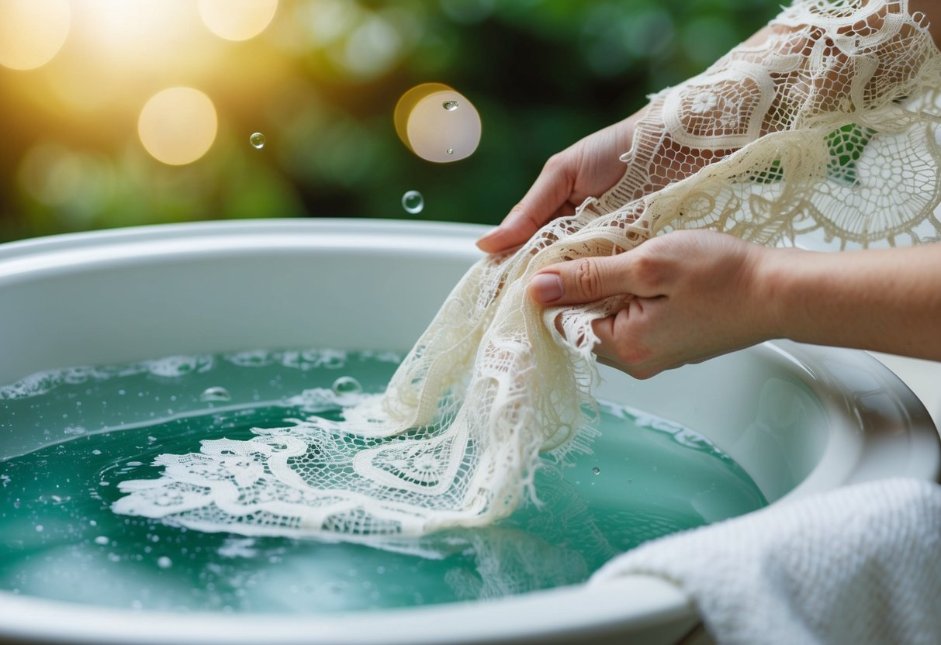Preserving the beauty and integrity of your finest garments with gentle washing, proper storage, and expert repair techniques
Lace fabric adds elegance and beauty to clothing and home decor, but its delicate nature requires special attention to maintain its charm. To properly care for lace, always hand wash in lukewarm water with a mild detergent, avoid wringing or twisting, and lay flat to dry away from direct sunlight to prevent damage to the delicate fibres. Vintage lace pieces need extra gentle handling to preserve their historical beauty and prevent deterioration.
Taking proper care of lace ensures it maintains its intricate patterns and structural integrity for years to come. The right cleaning approach depends on the specific type of lace, as different varieties require varying levels of care. Some modern laces can withstand machine washing on a gentle cycle, while antique or handmade pieces demand more careful treatment.
On This Page
Key Takeaways
- Regular gentle cleaning and proper storage protect lace’s delicate structure and appearance
- Hand washing with mild detergent provides the safest method for cleaning most lace items
- Careful drying and storage away from direct sunlight prevents yellowing and fabric breakdown
Identifying Types of Lace Fabric
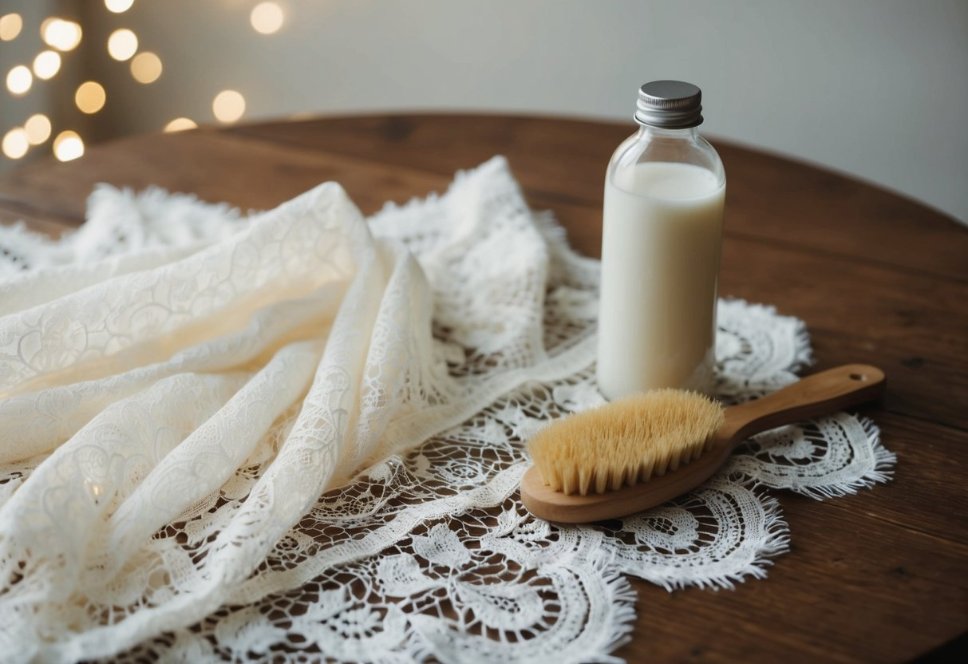
Different lace fabrics have unique patterns, textures, and manufacturing methods that make them distinct. By examining these characteristics closely, anyone can learn to spot the differences between handmade and machine-made lace varieties.
The History of Lace-Making
Lace-making began in Europe during the 15th century as a handcraft. Skilled artisans created intricate patterns using fine threads of silk, linen, and cotton.
Traditional handmade lace features precise, detailed patterns with clear borders and defined edges. Each piece shows consistent tension in the thread work.
Machine-made lace emerged during the Industrial Revolution. These pieces often display more uniform patterns and may have a less intricate appearance.
Differentiating Lace Types
Chantilly lace has a delicate, flowing pattern with fine detail work on a net background. Its patterns often feature flowers and ribbons.
Guipure lace is heavier and has no net background. The patterns connect directly to each other, creating a bold, raised appearance.
Synthetic laces are typically made from nylon or polyester. They tend to have a slight sheen and feel less soft than natural fibre laces.
To identify lace types, examine these key features:
- Pattern complexity
- Background mesh presence
- Thread thickness
- Edge finishing
- Material texture
Basic Lace Care Principles

Proper care and maintenance of lace requires gentle handling techniques and careful attention to cleaning methods. The right approach helps preserve the fabric’s delicate structure and extends its lifespan.
Handling Delicate Fabrics
Delicate lace items need careful handling to maintain their beauty. Always wash hands before touching lace to prevent oils and dirt from damaging the fibres.
Store lace pieces flat in acid-free tissue paper. Never fold lace sharply, as this can weaken or break the intricate threads.
Use padded hangers for lace garments. Avoid plastic containers that can trap moisture and promote mould growth.
Common Challenges in Lace Care
Gentle cleaning methods are essential for proper lace maintenance. Use lukewarm water and mild, non-alkaline detergents specifically designed for delicate fabrics.
Never wring or twist lace whilst washing. Pat gently with a clean white towel to remove excess water.
Watch for these common issues:
- Yellowing from improper storage
- Snags from jewellery or rough surfaces
- Weakening fibres from direct sunlight
- Damage from harsh detergents
Place lace items in mesh bags when machine washing is necessary. Use the gentlest cycle available and cold water to prevent damage.
Washing Lace Correctly
Proper cleaning methods keep lace looking beautiful and prevent damage to its delicate fibres. The right techniques and products make all the difference in maintaining the fabric’s integrity.
Choosing the Right Cleaning Agents
Use a gentle pH-balanced detergent specifically designed for delicate fabrics. Avoid any harsh chemicals, bleach, or brightening agents.
Choose lukewarm or cold water, as hot water can weaken the fibres and cause shrinkage.
Never use fabric softeners on lace, as they can leave residue and damage the material.
The Hand-Washing Process
Fill a clean basin with cold water and add a small amount of mild detergent. Gently submerge the lace and let it soak for 30 minutes.
Carefully squeeze the soapy water through the fabric. Do not wring, twist, or scrub the material.
Rinse thoroughly with clean, cold water until all soap residue is gone.
Press the lace between clean white towels to remove excess water. Never wring or squeeze aggressively.
Machine-Washing Tips
Place lace items in a mesh laundry bag or silk pillowcase to protect them during washing.
Use these settings for machine washing:
- Cold water temperature
- Delicate or gentle cycle
- Slow spin speed
- Minimal agitation
Remove lace items promptly after the cycle ends to prevent wrinkles and damage.
Lay the lace flat to dry on a clean white towel away from direct sunlight.
Effective Stain Removal for Lace
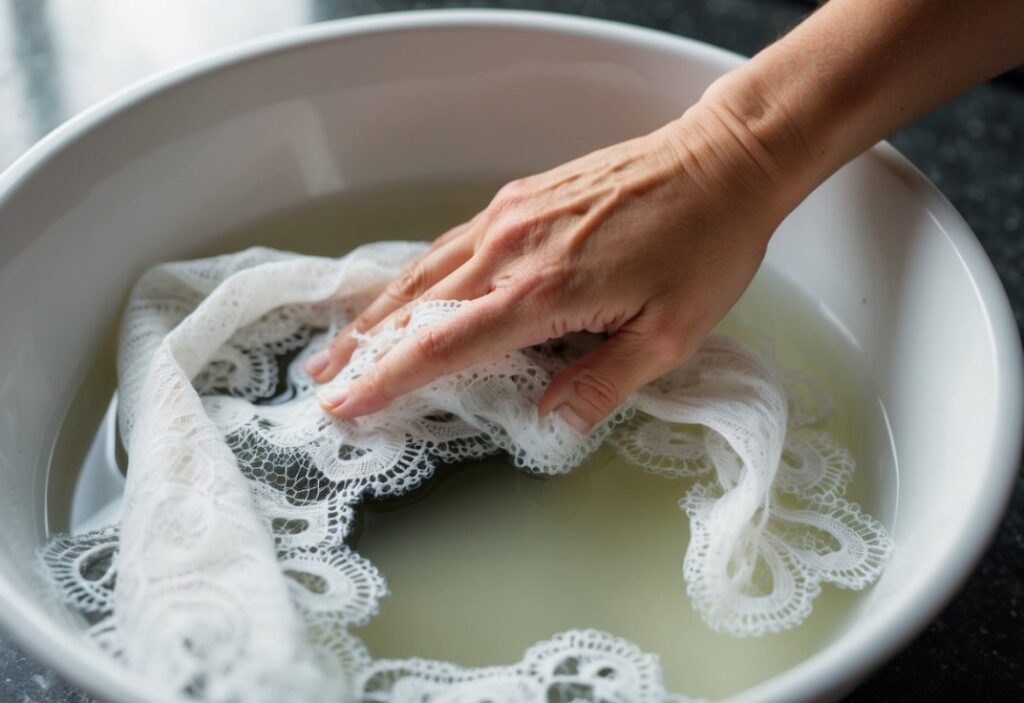
Removing stains from delicate lace requires precise techniques and gentle handling. The right approach prevents damage while effectively lifting spots and marks.
Pre-treatment Strategies
Always test cleaning solutions on a small, hidden area first to check for adverse reactions. This step takes just a few minutes but can prevent permanent damage.
Gently place white tissue paper under the stained area to prevent the stain from spreading. This also helps absorb excess moisture during cleaning.
Map out the stained areas before starting. This helps track progress and ensures no spots are missed.
DIY Stain Removal Techniques
Create a mild cleaning solution using lukewarm water and 2-3 drops of gentle detergent. Avoid harsh chemicals that can weaken fibres.
Gentle Methods:
- Blot the stain – never rub
- Use a soft white cloth
- Work from the outside towards the centre
Place the damp lace flat between clean white towels after cleaning. Press gently to remove excess water without wringing or twisting.
For stubborn stains, a solution of white vinegar and water (1:3 ratio) can be effective. Apply with a cotton swab using light dabbing motions.
Drying Lace Items Properly
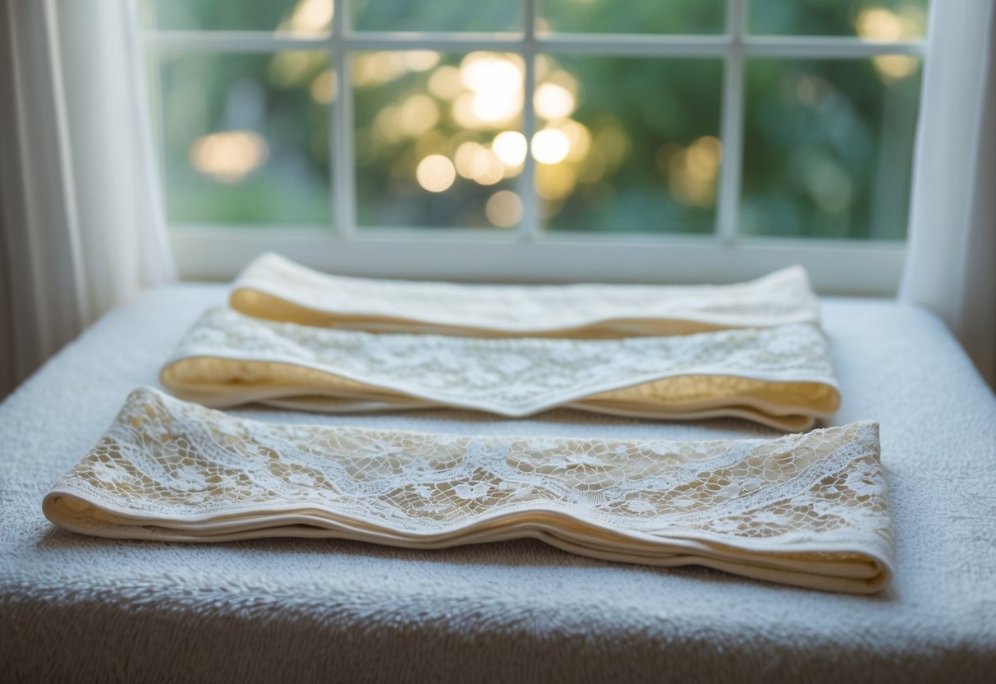
The proper drying technique keeps lace looking pristine and prevents damage to the delicate fibres. Gentle handling and the right drying environment make all the difference.
Air-Drying Techniques
Lay lace items flat on a clean, white cotton towel. First, roll the lace in the towel to remove excess water without wringing or twisting.
Place the damp lace on a fresh, dry towel or mesh drying rack. Ensure the item lies completely flat and reshape whilst damp.
Never hang wet lace, as the weight of the water can stretch and distort the pattern.
Keep lace away from direct sunlight whilst drying to prevent yellowing and fabric degradation.
Avoiding Heat Damage
Never tumble dry lace items, as the heat and agitation will damage the delicate threads and potentially create tears.
Avoid placing lace directly on radiators or heated drying racks. The intense heat can weaken fibres and cause shrinkage.
If ironing is necessary, wait until the lace is completely dry. Use the lowest heat setting and place a pressing cloth between the iron and lace to protect the fabric.
Store lace items only when fully dry to prevent mildew growth.
Ironing Lace Fabric Safely
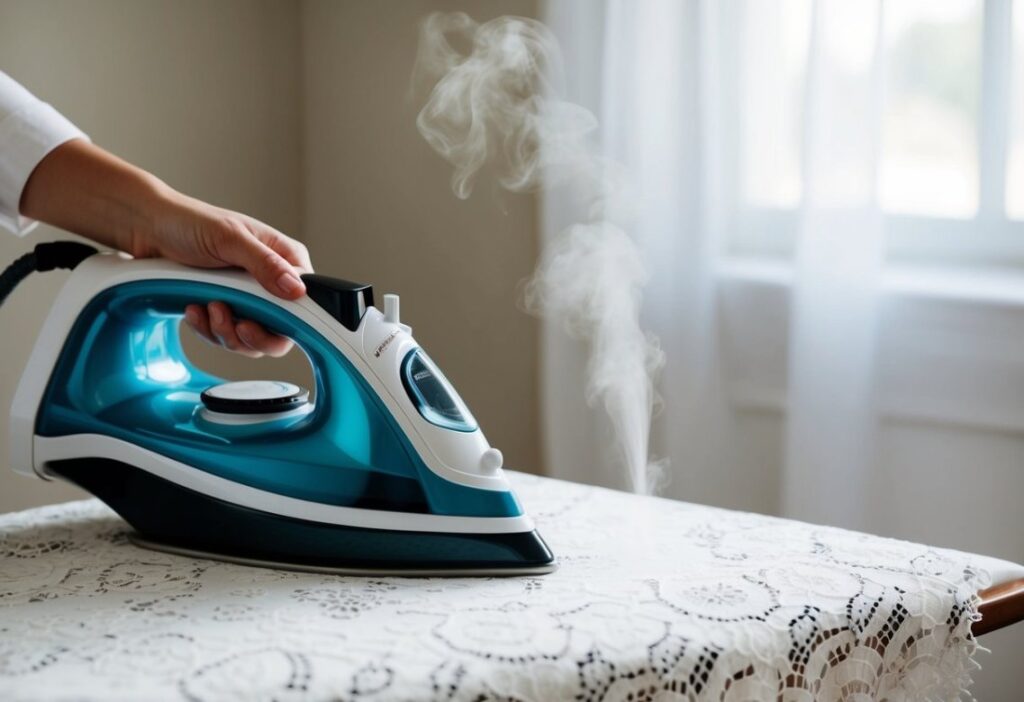
Using the right ironing techniques helps preserve delicate lace whilst removing unwanted wrinkles. The key is to use low heat and proper protection.
Setting Up for Ironing
Start by checking the fabric care label for specific temperature guidelines. Set the iron to its lowest heat setting to prevent scorching or melting the delicate fibres.
A padded ironing board provides essential cushioning for the lace pattern. The surface should be clean and free from debris that could snag the material.
Iron the lace whilst it’s slightly damp for best results. If the fabric is dry, use a light mist of water from a spray bottle.
Using a Pressing Cloth
A pressing cloth acts as a protective barrier between the iron and lace. Use a white cotton cloth or thin towel to prevent colour transfer.
Place the pressing cloth directly on top of the lace. This extra layer prevents direct contact with the iron’s hot surface.
Hover the iron slightly above the pressing cloth and use gentle steam. Move the iron in smooth, continuous motions without pressing down heavily.
Test a small, hidden area first to ensure the temperature won’t damage the lace. If any scorching occurs, reduce the heat immediately.
Professional Care for Lace
Professional dry cleaning services specialise in handling delicate fabrics with expert techniques and solutions not available for home use.
When to Consult a Professional
Antique or heirloom lace pieces need professional cleaning to preserve their integrity and value. A dry cleaner should be consulted for lace garments with deep stains, yellowing, or significant damage.
Expert cleaners use specialised solvents and techniques to remove stubborn marks without damaging delicate fibres. They can also repair small tears and loose threads.
Lace wedding dresses and formal wear require professional attention before and after special events. The intricate beading and embellishments on these pieces need careful handling that home cleaning cannot provide.
Many dry cleaners offer protective packaging services to keep cleaned lace items safe from dust and damage during storage. Some also provide restoration services for vintage lace that has become discoloured or brittle with age.
Important: Always check a dry cleaner’s experience with lace before trusting them with valuable pieces. Request references or examples of their previous work with similar items.
Storing Lace Fabric Properly
Proper storage techniques protect lace from damage and help maintain its beauty for years to come. The right storage environment and careful handling make a significant difference in preserving delicate lace pieces.
Avoiding Environmental Damage
Keep lace away from direct sunlight to prevent yellowing and fabric deterioration. Store items in a cool, dry space with stable temperature and humidity levels.
Plastic containers can trap moisture and cause mildew. Instead, use acid-free tissue paper or cotton storage bags that allow the fabric to breathe.
Never store lace in basements or attics where temperature fluctuations can harm the fibres. The ideal storage area should maintain 18-22°C with 45-55% relative humidity.
Best Practices for Long-Term Storage
Clean lace thoroughly before storage to prevent stains from setting. Roll larger pieces around acid-free cardboard tubes rather than folding to avoid permanent creases.
Essential storage supplies:
- Acid-free tissue paper
- Muslin or cotton storage bags
- Cardboard tubes for rolling
- Cedar blocks for pest prevention
Place tissue paper between layers when stacking multiple pieces. Avoid using metal hangers or pins that might rust or snag the fabric.
Check stored lace every 3-4 months for signs of damage or pest activity. Gentle refolding helps prevent stress on the same areas over time.
Frequently Asked Questions
Proper care techniques make a significant difference in keeping lace beautiful and long-lasting. Gentle cleaning methods and careful storage protect delicate lace fibres from wear and damage.
What steps should be taken to ensure lace remains in excellent condition?
Gentle handling and proper washing techniques are essential for maintaining lace. Regular inspection helps spot any loose threads or weak areas early.
Store lace items flat or rolled rather than hanging to prevent stretching. Keep lace away from direct sunlight to avoid yellowing or weakening of the fibres.
Which cleaning agents are suitable for maintaining the quality of lace garments?
Use mild, non-alkaline detergents specifically designed for delicate fabrics. Avoid bleach and harsh chemicals that can damage lace fibres.
Test cleaning products on a small, hidden area first. Skip fabric softeners, which can leave residue and weaken the material.
How should lace apparel be stored to prevent damage over time?
Professional fabric care specialists recommend storing lace items in acid-free tissue paper. Place items in a cool, dry place away from direct light.
Clean lace thoroughly before storage to prevent stains from setting. Use padded hangers if hanging is necessary, though flat storage is preferred.
Can lace items be ironed, and if so, what is the proper technique?
Use a low heat setting and place a white cotton cloth between the iron and lace. Iron on the wrong side of the fabric when possible.
Never slide the iron across lace. Instead, press gently and lift the iron to move to the next section.
What practices should be strictly avoided to preserve the integrity of lace fabric?
Avoid harsh scrubbing or wringing of lace items. Never use hot water, which can cause shrinkage and damage.
Skip the dryer and never expose lace to direct heat sources. Avoid storing lace in plastic bags, which can trap moisture.
Are there any specific hand-washing guidelines for delicate lace pieces?
Fill a basin with lukewarm water and gentle detergent. Submerge the lace and gently squeeze the soapy water through the fabric.
Rinse thoroughly without wringing or twisting. Pat excess water with a clean white towel and lay flat to dry on a fresh towel.

